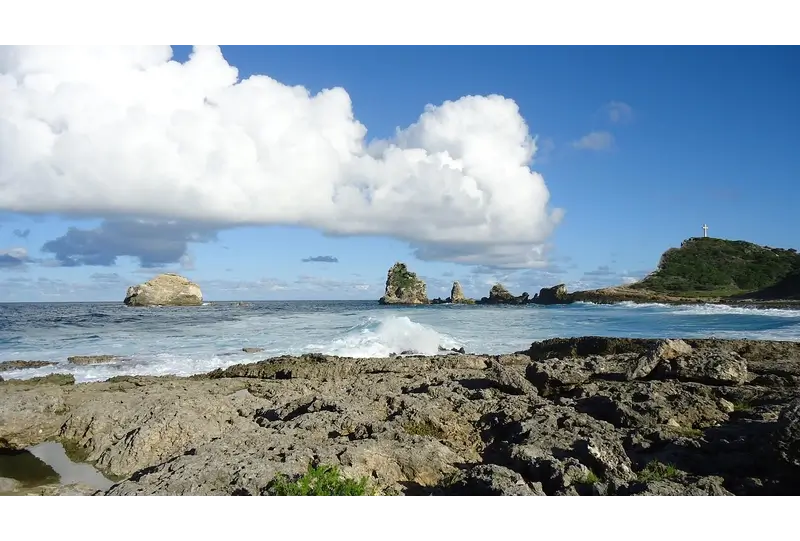Getting to Guadeloupe Island is easier than you might think. With several travel options available, planning your trip can be simple and enjoyable.
Hey friends, gather around! I’m super excited to share my journey to Guadeloupe Island in the Caribbean. This stunning destination, with its butterfly-shaped islands, lush rainforests, and vibrant Creole culture, stole my heart. As an experienced traveler, I’ve navigated my way to this gem and want to spill all the details on how you can get there too. Let’s dive into the best ways to reach Guadeloupe, from flights to ferries, and everything in between.
Why Guadeloupe Is Worth the Trip
Picture this: turquoise waters lapping at golden beaches, volcanic peaks begging to be hiked, and markets buzzing with local flavors. Guadeloupe, a French overseas territory, blends Caribbean vibes with French flair. I fell in love with its mix of adventure and relaxation. Whether you’re craving a beach day or a cultural deep dive, this place has it all. Knowing how to get there is the first step to unlocking its magic.

Flying to Guadeloupe: Your Main Gateway
Booking the Right Flight
Flying is the easiest way to reach Guadeloupe. Most international travelers land at Pointe-à-Pitre International Airport (PTP) on Grande-Terre. I started my trip from New York, and let me tell you, finding the right flight was key. Major airlines like Air France, American Airlines, and JetBlue offer direct or connecting flights from the U.S. I booked with Air France for a smooth connection through Paris, but you can also find routes via Miami or Montreal.
Tips for Affordable Airfare
Airfare can be pricey, but I’ve got tricks to keep costs down. Book at least two months in advance—prices spike closer to the date. Use tools like Google Flights to compare prices and set alerts. I snagged a round-trip ticket for about $600 by traveling in the shoulder season (April-May). Avoid peak times like Christmas or Carnival season for better deals.
Connecting Flights and Layovers
If you’re not near a major hub, you’ll likely have a layover. My flight had a quick stop in Miami, which gave me time to stretch and grab a coffee. Check layover times when booking—too short, and you’re rushing; too long, and you’re bored. Aim for 2-3 hours. Most connecting flights to Guadeloupe go through Paris, Miami, or San Juan.
Airport Arrival Tips
Landing at PTP is straightforward, but it’s a small airport, so expect some waiting at customs. I had my passport and hotel details ready, which sped things up. Currency is the Euro, so I exchanged some cash at the airport (though ATMs are better for rates). Taxis and car rentals are right outside—more on that later!
Alternative Routes: Ferries to Guadeloupe
Island-Hopping by Ferry
If you’re already in the Caribbean, ferries are a scenic way to reach Guadeloupe. I took a ferry from Martinique once, and the views were unreal. Companies like L’Express des Îles and Jeans for Freedom run routes from Martinique, Dominica, and Saint Lucia. The ride from Martinique to Pointe-à-Pitre takes about 3.5 hours and costs around €50-€70.

Booking Ferry Tickets
Book ferry tickets online a week ahead, especially in high season (December-April). I used the ferry company’s website and printed my ticket to avoid hiccups. Ferries can get bumpy, so pack motion sickness pills if you’re prone to seasickness. I popped one and enjoyed the ride with a breeze in my hair.
Pros and Cons of Ferries
Ferries are cheaper than flights and let you soak in the Caribbean Sea. You’ll see islands like Dominica pass by, which is a treat. But schedules can be unreliable, and rough seas might delay trips. I’d recommend ferries for shorter hops or if you’re combining Guadeloupe with nearby islands. It’s an adventure worth trying!
Getting Around Once You Land
Renting a Car for Freedom
Renting a car is my go-to in Guadeloupe. The islands of Grande-Terre and Basse-Terre are best explored on your own schedule. I rented a compact car from Hertz at PTP for about €30/day. Roads are decent, but Basse-Terre’s hilly terrain can be tricky—opt for a car with good handling. Book in advance for better rates and availability.
Public Transport Options
If driving isn’t your thing, public buses are an option, though they’re not super reliable. Buses connect major towns like Pointe-à-Pitre and Basse-Terre, but schedules are loose. I took a bus once from Pointe-à-Pitre to Gosier for €2, and it was a fun, local experience. Just be ready for a relaxed pace and crowded seats.
Taxis and Rideshares
Taxis are plentiful at the airport and tourist spots. A ride from PTP to Pointe-à-Pitre costs about €20-€30. I used a taxi to get to my hotel in Gosier, and the driver shared local tips, which was a bonus. Rideshares like Uber aren’t common, so stick to taxis or arrange transfers through your hotel.
Planning Your Travel Logistics
Best Time to Visit Guadeloupe
Timing your trip matters. I visited in May, and the weather was perfect—warm but not too humid. The dry season (December-May) is ideal for sunny days, but it’s pricier. The wet season (June-November) brings rain and hurricane risks but lower costs. Check weather forecasts and avoid peak hurricane months (August-September).
Visa and Entry Requirements
As a U.S. citizen, I didn’t need a visa for stays up to 90 days. Your passport should be valid for at least three months beyond your departure date. EU citizens have it easy—no visa, just a passport. Always check entry rules for your country on the French consulate’s website. I carried a digital copy of my passport, just in case.
Packing for Guadeloupe
Pack light, breathable clothes for the tropical climate. I brought shorts, t-shirts, and a light rain jacket for sudden showers. Don’t forget swimwear, sunscreen, and hiking shoes for trails like La Soufrière volcano. A reusable water bottle saved me during long beach days. Keep essentials in your carry-on in case luggage gets delayed.

Budgeting for Your Trip
Flight and Ferry Costs
Flights from the U.S. to Guadeloupe typically range from $500-$1,000 round-trip, depending on the season. My Miami connection was on the lower end because I booked early. Ferries from nearby islands cost €50-€100 one-way. Budget extra for taxes and baggage fees, which can add up.
Ground Transportation Costs
Car rentals average €25-€50 per day, depending on the vehicle. Gas is pricey (about €1.50/liter), so plan for that. Taxis and buses are cheaper but less flexible. I spent about €100 on transport for a week, including a rental car and a few taxi rides.
Accommodation and Food
Hotels range from €80/night for budget spots to €200+ for resorts. I stayed at a cozy Airbnb in Sainte-Anne for €90/night and loved the local vibe. Meals are affordable—think €10-€20 for a Creole dish like accras (fish fritters). Street food is even cheaper and just as tasty.
Exploring Guadeloupe: Why You’ll Love It
Beaches and Nature
Guadeloupe’s beaches are unreal. I spent a day at Plage de la Caravelle, lounging under palm trees with crystal water lapping at my feet. Basse-Terre’s rainforests are a hiker’s dream—I trekked to Carbet Falls and felt like I was in a jungle movie. Pack bug spray for those trails!

Cultural Vibes
The Creole culture is vibrant. I wandered through Pointe-à-Pitre’s markets, sampling spices and chatting with vendors. The annual Carnival (January-February) is a must if you time it right—think colorful parades and music. I learned a few French phrases, which locals appreciated.
Foodie Heaven
Food in Guadeloupe is a highlight. I devoured bokit (fried bread sandwiches) from street stalls and sipped ti’ punch, a rum cocktail. Restaurants in Gosier serve fresh seafood—my lobster dinner was a splurge at €30 but worth it. Don’t skip the local markets for cheap, delicious eats.
Practical Tips from My Experience
Language Tips
French is the official language, but Creole is widely spoken. I brushed up on basic French phrases like “Bonjour” and “Merci.” Locals are friendly and often speak some English, especially in tourist areas. A translation app like Google Translate was a lifesaver for menus and signs.
Currency and Payments
The Euro is the currency, and cards are widely accepted. I carried some cash for markets and small vendors, as they sometimes don’t take cards. ATMs are easy to find in Pointe-à-Pitre and Gosier. Exchange rates at the airport aren’t great, so use a bank or ATM instead.
Staying Safe
Guadeloupe is generally safe, but I stayed cautious. Keep valuables secure, especially in crowded markets. Avoid isolated areas at night, and check for travel advisories before you go. I had no issues, but it’s smart to stay aware.
Combining Guadeloupe with Other Islands
Island-Hopping Adventures
Guadeloupe is a great base for exploring nearby islands. I took a day trip to Marie-Galante, a smaller island with pristine beaches. Ferries make it easy to visit Dominica or Saint Lucia too. Plan a multi-island itinerary if you have time—it’s a fantastic way to see more of the Caribbean.
Planning a Multi-Island Trip
Book ferries or short flights in advance for island-hopping. I flew to Saint Lucia on a small plane for €100, and the views were breathtaking. Check visa rules for other islands, as they differ from Guadeloupe’s. Pack light to make island transitions smoother.
My Favorite Guadeloupe Moments
One of my best memories was watching the sunset at Pointe des Châteaux. The cliffs and waves were stunning, and I felt so at peace. Another highlight was hiking La Soufrière volcano—tough but rewarding with epic views. These moments made the trip unforgettable. I can’t wait for you to experience them too!
Frequently Asked Questions
Do I need a visa to visit Guadeloupe?
If you’re from the U.S., Canada, or EU, no visa is needed for stays up to 90 days. Check French consulate rules for other nationalities.
What’s the cheapest way to get to Guadeloupe?
Flights from Miami or San Juan are often the cheapest, starting at $500 round-trip. Ferries from nearby islands cost €50-€100.
When is the best time to visit Guadeloupe?
The dry season (December-May) is ideal for good weather. May and November offer fewer crowds and lower prices.
Are ferries reliable for getting to Guadeloupe?
Ferries are scenic but can be delayed by weather. Book early and check schedules for reliability.
Can I use U.S. dollars in Guadeloupe?
No, the currency is the Euro. Bring Euros or use ATMs for better exchange rates.
How long does it take to fly to Guadeloupe?
Direct flights from Miami take about 3.5 hours. Connecting flights from the U.S. take 6-10 hours, depending on layovers.
Conclusion
Getting to Guadeloupe Island in the Caribbean is easier than you think, and the journey is worth every second. Whether you fly into Pointe-à-Pitre or hop a ferry from Martinique, you’re in for a treat. My trip was a mix of adventure, culture, and pure relaxation, and I’m already planning my next visit. Follow these tips, pack smart, and get ready for an unforgettable escape. So, who’s coming with me next time?



